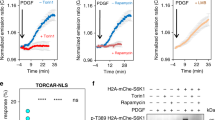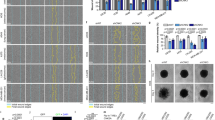Abstract
Rapamycin, an inhibitor of the mammalian target of rapamycin (mTOR), inhibits tumor cell motility. However, the underlying mechanism is poorly understood. Here, we show that rapamycin inhibited type I insulin-like growth factor (IGF-I)-stimulated motility of a panel of cell lines. Expression of a rapamycin-resistant mutant of mTOR (mTORrr) prevented rapamycin inhibition of cell motility. However, cells expressing a kinase-dead mTORrr remained sensitive to rapamycin. Downregulation of raptor or rictor by RNA interference (RNAi) decreased cell motility. However, only downregulation of raptor mimicked the effect of rapamycin, inhibiting phosphorylation of S6 kinase 1 (S6K1) and 4E-BP1. Cells infected with an adenovirus expressing constitutively active and rapamycin-resistant mutant of p70 S6K1, but not with an adenovirus expressing wild-type S6K1, or a control virus, conferred to resistance to rapamycin. Further, IGF-I failed to stimulate motility of the cells, in which S6K1 was downregulated by RNAi. Moreover, downregulation of eukaryotic initiation factor 4E (eIF4E)-binding protein 1 (4E-BP1) by RNAi-attenuated rapamycin inhibition of cell motility. In contrast, expression of constitutively active 4E-BP1 dramatically inhibited IGF-I-stimulated cell motility. The results indicate that both S6K1 and 4E-BP1 pathways, regulated by TORC1, are required for cell motility. Rapamycin inhibits IGF-I-stimulated cell motility, through suppression of both S6K1 and 4E-BP1/eIF4E-signaling pathways, as a consequence of inhibition of mTOR kinase activity.
This is a preview of subscription content, access via your institution
Access options
Subscribe to this journal
Receive 50 print issues and online access
$259.00 per year
only $5.18 per issue
Buy this article
- Purchase on Springer Link
- Instant access to full article PDF
Prices may be subject to local taxes which are calculated during checkout










Similar content being viewed by others
References
Andre F, Rigot V, Thimonier J, Montixi C, Parat F, Pommier G et al. (1999). Int J Cancer 83: 497–505.
Attoub S, Noe V, Pirola L, Bruyneel E, Chastre E, Mareel M et al. (2000). FASEB J 14: 2329–2338.
Berven LA, Willard FS, Crouch MF . (2004). Exp Cell Res 296: 183–195.
Beuvink I, Boulay A, Fumagalli S, Zilbermann F, Ruetz S, O'Reilly T et al. (2005). Cell 120: 747–759.
Bjornsti MA, Houghton PJ . (2004). Nat Rev Cancer 4: 335–348.
Boffa DJ, Luan F, Thomas D, Yang H, Sharma VK, Lagman M et al. (2004). Clin Cancer Res 10: 293–300.
Brunn GJ, Hudson CC, Sekulic A, Williams JM, Hosoi H, Houghton PJ et al. (1997). Science 277: 99–101.
Cartwright JE, Tse WK, Whitley GS . (2002). Exp Cell Res 279: 219–226.
Dennis PB, Jaeschke A, Saitoh M, Fowler B, Kozma SC, Thomas G . (2001). Science 294: 1102–1105.
Dennis PB, Pullen N, Kozma SC, Thomas G . (1996). Mol Cell Biol 16: 6242–6451.
El-Badry OM, Minniti C, Kohn EC, Houghton PJ, Daughaday WH, Helman LJ . (1990). Cell Growth Differ 1: 325–331.
Erbay E, Chen J . (2001). J Biol Chem 276: 36079–36082.
Fingar DC, Richardson CJ, Tee AR, Cheatham L, Tsou C, Blenis J . (2004). Mol Cell Biol 24: 200–216.
Fingar DC, Salama S, Tsou C, Harlow E, Blenis J . (2002). Genes Dev 16: 1472–1487.
Gallicchio MA, Kaun C, Wojta J, Binder B, Bach LA . (2003). J Cell Physiol 197: 131–138.
Gingras AC, Kennedy SG, O'Leary MA, Sonenberg N, Hay N . (1998). Genes Dev 12: 502–513.
Gingras AC, Raught B, Gygi SP, Niedzwiecka A, Miron M, Burley SK et al. (2001). Genes Dev 15: 2852–2864.
Gomez-Cambronero J . (2003). FEBS Lett 550: 94–100.
Guba M, von Breitenbuch P, Steinbauer M, Koehl G, Flegel S, Hornung M et al. (2002). Nat Med 8: 128–135.
Hara K, Maruki Y, Long X, Yoshino K, Oshiro N, Hidayat S . (2002). Cell 110: 177–189.
Hassid A, Yao J, Huang S . (1999). Am J Physiol 277: H1014–H1026.
He TC, Zhou S, da Costa LT, Yu J, Kinzler KW, Vogelstein B . (1998). Proc Natl Acad Sci USA 95: 2509–2514.
Holz MK, Ballif BA, Gygi SP, Blenis J . (2005). Cell 123: 569–580.
Hosoi H, Dilling MB, Liu LN, Danks MK, Shikata T, Sekulic A et al. (1998). Mol Pharmacol 54: 815–824.
Hosoi H, Dilling MB, Shikata T, Liu LN, Shu L, Ashmun RA et al. (1999). Cancer Res 59: 886–894.
Huang S, Houghton PJ . (2003). Curr Opin Pharmacol 3: 371–377.
Huang S, Shu L, Dilling MB, Easton J, Harwood FC, Ichijo H et al. (2003). Mol Cell 11: 1491–1501.
Jacinto E, Loewith R, Schmidt A, Lin S, Ruegg MA, Hall A et al. (2004). Nat Cell Biol 6: 1122–1128.
Kanellopoulou C, Muljo SA, Kung AL, Ganesan S, Drapkin R, Jenuwein T et al. (2005). Genes Dev 19: 489–501.
Kim DH, Sarbassov DD, Ali SM, King JE, Latek RR, Erdjument-Bromage H et al. (2002). Cell 110: 163–175.
Kwon YS, Hong HS, Kim JC, Shin JS, Son Y . (2005). Invest Ophthalmol Vis Sci 46: 454–460.
LeRoith D, Roberts Jr CT . (2003). Cancer Lett 195: 127–137.
Loewith R, Jacinto E, Wullschleger S, Lorberg A, Crespo JL, Bonenfant D et al. (2002). Mol Cell 10: 457–468.
Luan FL, Ding R, Sharma VK, Chon WJ, Lagman M, Suthanthiran M . (2003). Kidney Int 63: 917–926.
Martin DE, Hall MN . (2005). Curr Opin Cell Biol 17: 158–166.
Martin KA, Rzucidlo EM, Merenick BL, Fingar DC, Brown DJ, Wagner RJ et al. (2004). Am J Physiol Cell Physiol 286: C507–C517.
Meyer GE, Shelden E, Kim B, Feldman EL . (2001). Oncogene 20: 7542–7550.
Minniti CP, Kohn EC, Grubb JH, Sly WS, Oh Y, Muller HL et al. (1992). J Biol Chem 267: 9000–9004.
Mothe-Satney I, Yang D, Fadden P, Haystead TA, Lawrence Jr JC . (2000). Mol Cell Biol 20: 35558–35567.
Poon M, Marx SO, Gallo R, Badimon JJ, Taubman MB, Marks AR . (1996). J Clin Invest 98: 2277–2283.
Ridley AJ, Schwartz MA, Burridge K, Firtel RA, Ginsberg MH, Borisy G et al. (2003). Science 302: 1704–1709.
Rodriguez LG, Wu X, Guan JL . (2005). Methods Mol Biol 294: 23–29.
Rowinsky EK . (2004). Curr Opin Oncol 16: 564–575.
Sakakibara K, Liu B, Hollenbeck S, Kent KC . (2005). Am J Physiol Heart Circ Physiol 288: H2861–H2868.
Sarbassov DD, Ali SM, Kim DH, Guertin DA, Latek RR, Erdjument-Bromage H et al. (2004). Curr Biol 14: 1296–1302.
Sarbassov DD, Guertin DA, Ali SM, Sabatini DM . (2005). Science 307: 1098–1101.
Schalm SS, Tee AR, Blenis J . (2005). J Biol Chem 280: 11101–11106.
Sekulic A, Hudson CC, Homme JL, Yin P, Otterness DM, Karnitz LM et al. (2000). Cancer Res 60: 3504–3513.
Shapiro DN, Jones BG, Shapiro LH, Dias P, Houghton PJ . (1994). J Clin Invest 94: 1235–1242.
Shu L, Zhang X, Houghton PJ . (2002). J Biol Chem 277: 16726–16732.
Stolovich M, Tang H, Hornstein E, Levy G, Cohen R, Bae SS et al. (2002). Mol Cell Biol 22: 8101–8113.
Sun J, Marx SO, Chen HJ, Poon M, Marks AR, Rabbani LE . (2001). Circulation 103: 2967–2972.
Tai YT, Podar K, Catley L, Tseng YH, Akiyama M, Shringarpure R et al. (2003). Cancer Res 63: 5850–5858.
Takaishi K, Sasaki T, Takai Y . (1995). Methods Enzymol 256: 336–347.
Tang H, Hornstein E, Stolovich M, Levy G, Livingstone M, Templeton D et al. (2001). Mol Cell Biol 21: 8671–8683.
von Manteuffel SR, Dennis PB, Pullen N, Gingras AC, Sonenberg N, Thomas G . (1997). Mol Cell Biol 17: 5426–5436.
Wan X, Mendoza A, Khanna C, Helman LJ . (2005). Cancer Res 65: 2406–2411.
Wong AS, Roskelley CD, Pelech S, Miller D, Leung PC, Auersperg N . (2004). Exp Cell Res 299: 248–256.
Yuan Q, Viar MJ, Ray RM, Johnson LR . (2000). Am J Physiol Gastrointest Liver Physiol 278: G49–G56.
Zhang D, Brodt P . (2002). Oncogene 22: 974–982.
Acknowledgements
We thank Drs Robert T Abraham, Jun Chung, Peter J Houghton, John C Lawrence, David M Sabatini for providing cell lines or constructs. We are also grateful to Drs Peter J Houghton and Robert E Rhoads for their critical reading of this paper and helpful discussions. This work was supported in part by a Feist-Weiller Cancer Research Award (SH) and a Start-up Fund (SH) jointly from Louisiana State University Health Sciences Center in Shreveport, LA, USA.
Author information
Authors and Affiliations
Corresponding author
Rights and permissions
About this article
Cite this article
Liu, L., Li, F., Cardelli, J. et al. Rapamycin inhibits cell motility by suppression of mTOR-mediated S6K1 and 4E-BP1 pathways. Oncogene 25, 7029–7040 (2006). https://doi.org/10.1038/sj.onc.1209691
Received:
Revised:
Accepted:
Published:
Issue Date:
DOI: https://doi.org/10.1038/sj.onc.1209691
Keywords
This article is cited by
-
Mitochondrial Hydrogen Peroxide Activates PTEN and Inactivates Akt Leading to Autophagy Inhibition-Dependent Cell Death in Neuronal Models of Parkinson’s Disease
Molecular Neurobiology (2023)
-
Therapeutic silencing of mTOR by systemically administered siRNA-loaded neutral liposomal nanoparticles inhibits DMBA-induced mammary carcinogenesis
British Journal of Cancer (2022)
-
Inhibition of the mTOR pathway and reprogramming of protein synthesis by MDM4 reduce ovarian cancer metastatic properties
Cell Death & Disease (2021)
-
Copper depletion modulates mitochondrial oxidative phosphorylation to impair triple negative breast cancer metastasis
Nature Communications (2021)
-
Ivermectin reverses the drug resistance in cancer cells through EGFR/ERK/Akt/NF-κB pathway
Journal of Experimental & Clinical Cancer Research (2019)



